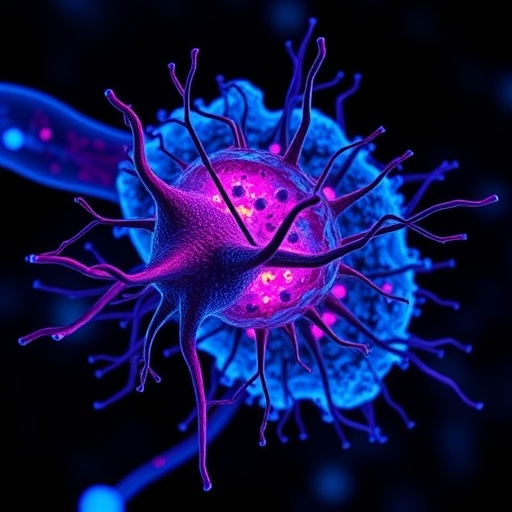A groundbreaking new textbook encapsulates over three decades of pioneering research into the intricate cellular phenomenon known as autophagy—a vital process responsible for the degradation and recycling of damaged or unnecessary cellular components. This comprehensive volume, Autophagy – From Molecular Mechanisms to Flux Control in Health and Disease, emerges as a pivotal resource for scientists and students alike who seek a deeper understanding of this complex and essential biological pathway.
Autophagy, derived from the Greek words meaning “self-eating,” serves as the cell’s housekeeping mechanism. Through this meticulously regulated process, cells identify and sequester defunct organelles, aggregated proteins, and invading pathogens into specialized vesicles known as autophagosomes. These vesicles subsequently fuse with lysosomes where the cargo is enzymatically degraded, and the resulting biomolecules recycled for cellular use. The physiological importance of autophagy is immense: it preserves cellular homeostasis, supports energy metabolism during nutrient deprivation, and orchestrates responses to a myriad of stress conditions. Dysfunction in autophagic pathways has been strongly implicated in diverse disease etiologies, including cancer, neurodegenerative disorders such as Alzheimer’s and Parkinson’s disease, and cardiovascular ailments.
The ambitious 335-page textbook represents the culmination of collaborative wisdom, spearheaded by Professor Ben Loos, Head of the Department of Physiological Sciences at Stellenbosch University, South Africa. With its integration of molecular insights and clinical implications, the text demystifies the multifaceted machinery that governs autophagy. Central to this machinery are over 20 core proteins that coordinate the initiation, nucleation, elongation, and closure of autophagosomes, along with numerous accessory factors modulating these stages. This biochemical choreography is not only complex but also context-dependent, varying across tissues and physiological states, thereby presenting significant challenges to educators and students navigating this rapidly evolving field.
Recognizing the pedagogical hurdles, the textbook is meticulously structured to bridge the gap between abstract molecular concepts and tangible understanding. It incorporates interactive elements such as quizzes, thought-provoking questions, and curated alerts to seminal research publications that have shaped the field. This educational innovation is especially crucial given the exponential growth in autophagy research, which makes discerning critical information increasingly difficult for newcomers. By adopting this novel approach, the textbook empowers users to grasp key regulatory nodes and flux dynamics within autophagic pathways.
A particularly notable contribution to this work stems from Dr. Nicola Heathcote, a PhD candidate under Prof. Loos at Stellenbosch University, whose expertise in correlative light and electron microscopy sheds new light on autophagy intermediates. Through painstaking quantitative image analysis spanning hundreds of cellular sections, Heathcote’s team has generated three-dimensional reconstructions of single autophagosomes, providing unprecedented resolution of their morphology and spatial context within cells. This methodological advancement not only validates molecular findings but also enhances conceptual clarity, offering readers a visually enriched perspective that complements biochemical data.
The implications of refined autophagy visualization extend beyond academic curiosity. Autophagy’s role in mitigating age-associated pathologies is a critical focus of ongoing research, especially relevant for aging populations in resource-limited regions. Dysfunctional autophagy exacerbates cellular senescence and metabolic imbalance, fueling progressive tissue degeneration characteristic of heart disease, neurodegenerative disorders, and oncogenesis. Against this backdrop, the textbook champions the significance of autophagic regulation as a therapeutic target, underscoring how foundational research can inform clinical strategies to ameliorate morbidity in socioeconomically vulnerable countries.
Importantly, the textbook’s availability in digital formats—pdf and Ebook—ensures broad accessibility, facilitating global dissemination and integration into university curricula worldwide. Its commissioning by leading academic institutions, including the Francis Crick Institute in London, highlights the cross-continental collaboration fueling advancements in autophagy research. This international partnership reinforces the universal relevance and translational potential of the field.
The textbook delves into the biochemical pathways underpinning autophagosome formation, highlighting core protein complexes such as ULK1 kinase initiation modules, the class III PI3K complex for phagophore nucleation, and the ATG12-ATG5-ATG16L1 elongation machinery. The tightly regulated ubiquitin-like conjugation systems operative during autophagosome membrane expansion exemplify the exquisite control mechanisms inherent in this process. Moreover, the book explores how selective autophagy operates to degrade specific substrates, mediated by autophagy receptors like p62/SQSTM1, which recognize ubiquitinated cargo, thereby linking autophagy to proteostasis and immune surveillance.
Apart from its molecular focus, the text addresses autophagic flux—the dynamic process encompassing autophagosome formation, lysosomal fusion, and cargo degradation—and the experimental approaches used to quantify it. This includes fluorescence microscopy assays, immunoblotting of autophagy markers such as LC3-II and p62, and emerging live-cell imaging techniques. The curriculum encourages readers to critically evaluate methodological limitations and interpret flux data in diverse experimental contexts.
Given the rapidly expanding landscape of autophagy-related research, the textbook situates current knowledge within an evolving framework, discussing emerging concepts like non-canonical autophagy pathways, interactions with apoptosis and necroptosis, and the influence of autophagy on cellular metabolism. These insights underline the functional versatility of autophagy, moving beyond simplistic recycling narratives to encompass regulation of immunity, inflammation, and organismal health.
Professor Loos envisions the textbook as a catalyst for educational renewal in the life sciences, remarking that it equips both students and seasoned investigators with tools to interrogate autophagy comprehensively. By equipping readers with mechanistic understanding and up-to-date methodologies, the book aims to accelerate discovery and foster meaningful translational applications.
In summary, this expansive textbook catalyzes a deeper, technically nuanced understanding of autophagy by integrating molecular biology, advanced imaging, and clinical relevance. Its collaborative genesis and pedagogical innovations position it as an indispensable resource at the forefront of cellular and molecular biology education, poised to inspire a new generation of scientists tackling the challenges posed by autophagy-associated diseases globally.
Subject of Research: Autophagy and its molecular mechanisms in health and disease
Article Title: A Comprehensive Guide to Autophagy: From Molecular Underpinnings to Clinical Impact
News Publication Date: Not specified
Web References:
Image Credits: Image courtesy of Nicola Heathcote
Keywords: Autophagy, autophagosomes, molecular mechanisms, cellular recycling, lysosome, selective autophagy, autophagic flux, electron microscopy, neurodegeneration, cancer, heart disease, cellular homeostasis




